The Impact of Inlet Structure on Stratification Performance in Thermal Storage Tanks: A Study through Simulation and Experimental Analysis
Abstract
Featured Application
Abstract
1. Introduction
2. Numerical Simulation Study of Thermal Storage Tanks
2.1. Physical Model
2.2. Mathematical Model
2.3. Boundary Conditions and Physical Properties
3. Experimental Study
3.1. Experimental Test Platform System
3.2. Experimental Process
3.3. Theory of Energy Calculation
3.3.1. Richardson Number
3.3.2. Hot Water Output Rates
3.3.3. MIX Number
3.3.4. Error Analysis
4. Results and Discussion
4.1. Grid Independence Verification
4.2. Time Step Independence Verification
4.3. Simulation and Experimental Results Analysis
4.3.1. Analysis of Temperature Profiles
4.3.2. Analysis of Richardson Number
4.3.3. Analysis of Hot Water Output Rates
4.3.4. Analysis of MIX Number
5. Conclusions
Author Contributions
Funding
Institutional Review Board Statement
Informed Consent Statement
Data Availability Statement
Conflicts of Interest
References
- Liu, Z.; Sun, T.; Yu, Y.; Ke, P.; Deng, Z.; Lu, C.; Huo, D.; Ding, X. Near-Real-Time Carbon Emission Accounting Technology Toward Carbon Neutrality. Engineering 2022, 14, 44–51. [Google Scholar] [CrossRef]
- Panwar, N.L.; Kaushik, S.C.; Kothari, S. Role of Renewable Energy Sources in Environmental Protection: A Review. Renew. Sustain. Energy Rev. 2011, 15, 1513–1524. [Google Scholar] [CrossRef]
- Kothari, R.; Tyagi, V.V.; Pathak, A. Waste-to-Energy: A Way from Renewable Energy Sources to Sustainable Development. Renew. Sustain. Energy Rev. 2010, 14, 3164–3170. [Google Scholar] [CrossRef]
- Pietrosemoli, L.; Rodriguez-Monroy, C. The Venezuelan Energy Crisis: Renewable Energies in the Transition towards Sustainability. Renew. Sust. Energ. Rev. 2019, 105, 415–426. [Google Scholar] [CrossRef]
- García-Marí, E.; Gasque, M.; Gutiérrez-Colomer, R.P.; Ibáñez, F.; González-Altozano, P. A New Inlet Device That Enhances Thermal Stratification during Charging in a Hot Water Storage Tank. Appl. Therm. Eng. 2013, 61, 663–669. [Google Scholar] [CrossRef]
- Haller, M.Y.; Cruickshank, C.A.; Streicher, W.; Harrison, S.J.; Andersen, E.; Furbo, S. Methods to Determine Stratification Efficiency of Thermal Energy Storage Processes—Review and Theoretical Comparison. Sol. Energy 2009, 83, 1847–1860. [Google Scholar] [CrossRef]
- Erdemir, D.; Altuntop, N. Improved Thermal Stratification with Obstacles Placed inside the Vertical Mantled Hot Water Tanks. Appl. Therm. Eng. 2016, 100, 20–29. [Google Scholar] [CrossRef]
- Njoku, H.O.; Ekechukwu, O.V.; Onyegegbu, S.O. Analysis of Stratified Thermal Storage Systems: An Overview. Heat Mass Transf. 2014, 50, 1017–1030. [Google Scholar] [CrossRef]
- Chandra, Y.P.; Matuska, T. Stratification Analysis of Domestic Hot Water Storage Tanks: A Comprehensive Review. Energy Build. 2019, 187, 110–131. [Google Scholar] [CrossRef]
- Lima, J.B.A.; Prado, R.T.A.; Montoro Taborianski, V. Optimization of Tank and Flat-Plate Collector of Solar Water Heating System for Single-Family Households to Assure Economic Efficiency through the TRNSYS Program. Renew. Energy 2006, 31, 1581–1595. [Google Scholar] [CrossRef]
- Shafieian, A.; Bahrami, H.-R.; Roostaee, A.; Feyzi, S.S. Effects of Different Inlet Configurations on the Performance of Solar Storage Tanks: A Three-Dimensional Unsteady CFD Simulation. Case Stud. Therm. Eng. 2023, 45, 103019. [Google Scholar] [CrossRef]
- Castell, A.; Medrano, M.; Solé, C.; Cabeza, L.F. Dimensionless Numbers Used to Characterize Stratification in Water Tanks for Discharging at Low Flow Rates. Renew. Energy 2010, 35, 2192–2199. [Google Scholar] [CrossRef]
- Eames, P.C.; Norton, B. The Effect of Tank Geometry on Thermally Stratified Sensible Heat Storage Subject to Low Reynolds Number Flows. Int. J. Heat Mass Transf. 1998, 41, 2131–2142. [Google Scholar] [CrossRef]
- Gao, L.; Lu, H.; Sun, B.; Che, D.; Dong, L. Numerical and Experimental Investigation on Thermal Stratification Characteristics Affected by the Baffle Plate in Thermal Storage Tank. J. Energy Storage 2021, 34, 102117. [Google Scholar] [CrossRef]
- Baines, W.D.; Martin, W.W.; Smith, D.M. Development of Stratification in a Rectangular Tank by Horizontal Inflow. J. Fluids Eng. 1983, 105, 59–64. [Google Scholar] [CrossRef]
- Wang, D.; Liu, H.; Wang, Y.; Liu, K.; Liu, Y.; Gao, M.; Fan, J. Thermal Performance and Evaluation of a Novel Stratified and Mixed Flexible Transformation Solar Heat Storage Unit. Build. Simul. 2023, 16, 1881–1895. [Google Scholar] [CrossRef]
- Wang, Z.; Zhang, H.; Dou, B.; Huang, H.; Wu, W.; Wang, Z. Experimental and Numerical Research of Thermal Stratification with a Novel Inlet in a Dynamic Hot Water Storage Tank. Renew. Energy 2017, 111, 353–371. [Google Scholar] [CrossRef]
- Hollands, K.G.T.; Lightstone, M.F. A Review of Low-Flow, Stratified-Tank Solar Water Heating Systems. Sol. Energy 1989, 43, 97–105. [Google Scholar] [CrossRef]
- Van Berkel, J. Mixing in Thermally Stratified Energy Stores. Sol. Energy 1996, 58, 203–211. [Google Scholar] [CrossRef]
- Garnier, C.; Muneer, T.; Currie, J. Numerical and Empirical Evaluation of a Novel Building Integrated Collector Storage Solar Water Heater. Renew. Energy 2018, 126, 281–295. [Google Scholar] [CrossRef]
- Wang, Z.; Zhang, H.; Dou, B.; Zhang, G.; Wu, W. Influence of Inlet Structure on Thermal Stratification in a Heat Storage Tank with PCMs: CFD and Experimental Study. Appl. Therm. Eng. 2019, 162, 114151. [Google Scholar] [CrossRef]
- Moncho-Esteve, I.J.; Gasque, M.; González-Altozano, P.; Palau-Salvador, G. Simple Inlet Devices and Their Influence on Thermal Stratification in a Hot Water Storage Tank. Energy Build. 2017, 150, 625–638. [Google Scholar] [CrossRef]
- Bahnfleth, W.P.; Song, J. Constant Flow Rate Charging Characteristics of a Full-Scale Stratified Chilled Water Storage Tank with Double-Ring Slotted Pipe Diffusers. Appl. Therm. Eng. 2005, 25, 3067–3082. [Google Scholar] [CrossRef]
- Yaïci, W.; Ghorab, M.; Entchev, E.; Hayden, S. Three-Dimensional Unsteady CFD Simulations of a Thermal Storage Tank Performance for Optimum Design. Appl. Therm. Eng. 2013, 60, 152–163. [Google Scholar] [CrossRef]
- Chung, J.D.; Cho, S.H.; Tae, C.S.; Yoo, H. The Effect of Diffuser Configuration on Thermal Stratification in a Rectangular Storage Tank. Renew. Energy 2008, 33, 2236–2245. [Google Scholar] [CrossRef]
- Qin, Y.; Wang, Z.; Zhang, H.; Dou, B.; Zhang, G.; Wu, W.; Wu, C. The Effect of Phase Change Material Balls on the Thermal Characteristics in Hot Water Tanks: CFD Research. Appl. Therm. Eng. 2020, 178, 115557. [Google Scholar] [CrossRef]
- Yang, Z.; Chen, H.; Wang, L.; Sheng, Y.; Wang, Y. Comparative Study of the Influences of Different Water Tank Shapes on Thermal Energy Storage Capacity and Thermal Stratification. Renew. Energy 2016, 85, 31–44. [Google Scholar] [CrossRef]
- Wu, F.; Wang, Z.; Zhang, H.; Qin, Y.; You, X.; Lu, J. Experimental and Simulation Analysis on Thermal Stratification Characteristics in Solar Storage Tanks with Phase Change Materials. J. Energy Storage 2022, 46, 103722. [Google Scholar] [CrossRef]
- Thermophysical Properties of Fluid Systems. Available online: https://webbook.nist.gov/chemistry/fluid/ (accessed on 26 March 2024).
- Fernández-Seara, J.; Uhı’a, F.J.; Sieres, J. Experimental Analysis of a Domestic Electric Hot Water Storage Tank. Part II: Dynamic Mode of Operation. Appl. Therm. Eng. 2007, 27, 137–144. [Google Scholar] [CrossRef]
- Kenjo, L.; Inard, C.; Caccavelli, D. Experimental and Numerical Study of Thermal Stratification in a Mantle Tank of a Solar Domestic Hot Water System. Appl. Therm. Eng. 2007, 27, 1986–1995. [Google Scholar] [CrossRef]
- Hariharan, K.; Badrinarayana, K.; Srinivasa Murthy, S.; Krishna Murthy, M.V. Temperature Stratification in Hot-Water Storage Tanks. Energy 1991, 16, 977–982. [Google Scholar] [CrossRef]
- Hahne, E.; Chen, Y. Numerical Study of Flow and Heat Transfer Characteristics in Hot Water Stores. Sol. Energy 1998, 64, 9–18. [Google Scholar] [CrossRef]
- Zurigat, Y.H.; Liche, P.R.; Ghajar, A.J. Influence of Inlet Geometry on Mixing in Thermocline Thermal Energy Storage. Int. J. Heat Mass Transf. 1991, 34, 115–125. [Google Scholar] [CrossRef]
- Gerhardt, F.L.C.; Salvo, R.d.V.; de Marchi Neto, I.; de Lima, R.S.; Silva, R.C. da Computational Modeling of a Thermal Energy Storage Tank Coupled to a Water-Cooled Household Refrigerator. J. Energy Storage 2021, 41, 102961. [Google Scholar] [CrossRef]
- Lavan, Z.; Thompson, J. Experimental Study of Thermally Stratified Hot Water Storage Tanks. Sol. Energy 1977, 19, 519–524. [Google Scholar] [CrossRef]
- Ghajar, A.J.; Zurigat, Y.H. Numerical Study of the Effect of Inlet Geometry on Stratification in Thermal Energy Storage. Numer. Heat Transf. Part A Appl. 1991, 19, 65–83. [Google Scholar] [CrossRef]
- Hegazy, A.A. Effect of Inlet Design on the Performance of Storage-Type Domestic Electrical Water Heaters. Appl. Energy 2007, 84, 1338–1355. [Google Scholar] [CrossRef]
- Andersen, E.; Furbo, S.; Fan, J. Multilayer Fabric Stratification Pipes for Solar Tanks. Sol. Energy 2007, 81, 1219–1226. [Google Scholar] [CrossRef]
- Wang, Z.; Zhang, H.; Dou, B.; Zhang, G.; Wu, W.; Zhou, L. An Experimental Study for the Enhancement of Stratification in Heat-Storage Tank by Equalizer and PCM Module. J. Energy Storage 2020, 27, 101010. [Google Scholar] [CrossRef]
- Oró, E.; Castell, A.; Chiu, J.; Martin, V.; Cabeza, L.F. Stratification Analysis in Packed Bed Thermal Energy Storage Systems. Appl. Energy 2013, 109, 476–487. [Google Scholar] [CrossRef]
- Huang, Z.; Wang, Z.L.; Zhang, H.; Huang, H.J. Experimental analysis of stratification characteristics of a new water storage tank. Nonferrous Met. Mater. Eng. 2017, 38, 273–279. (In Chinese) [Google Scholar]

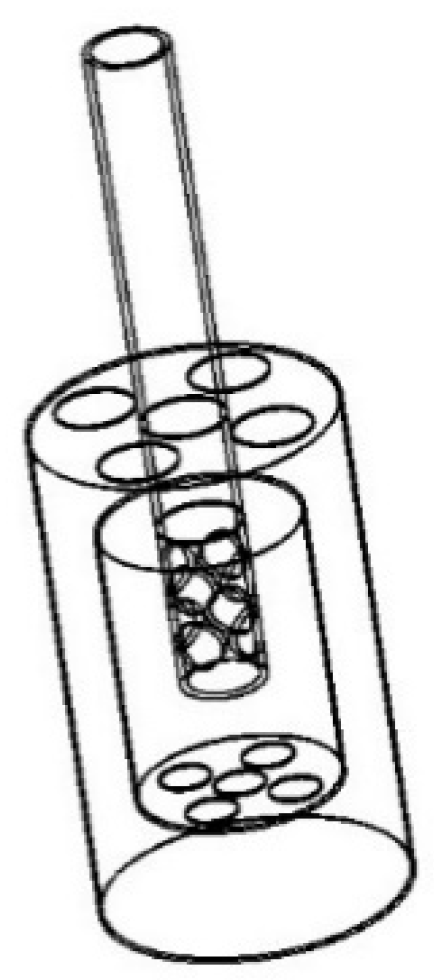


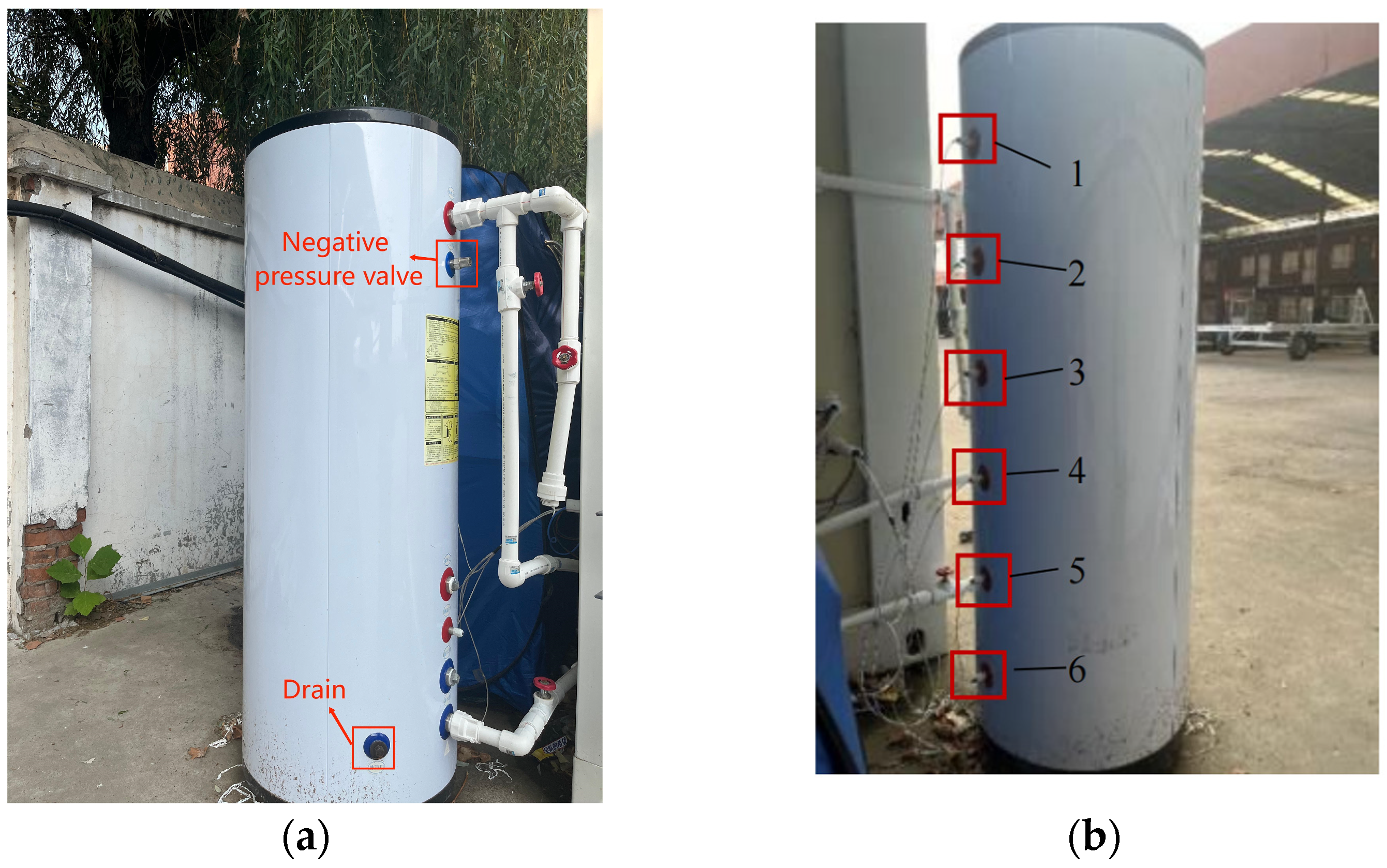

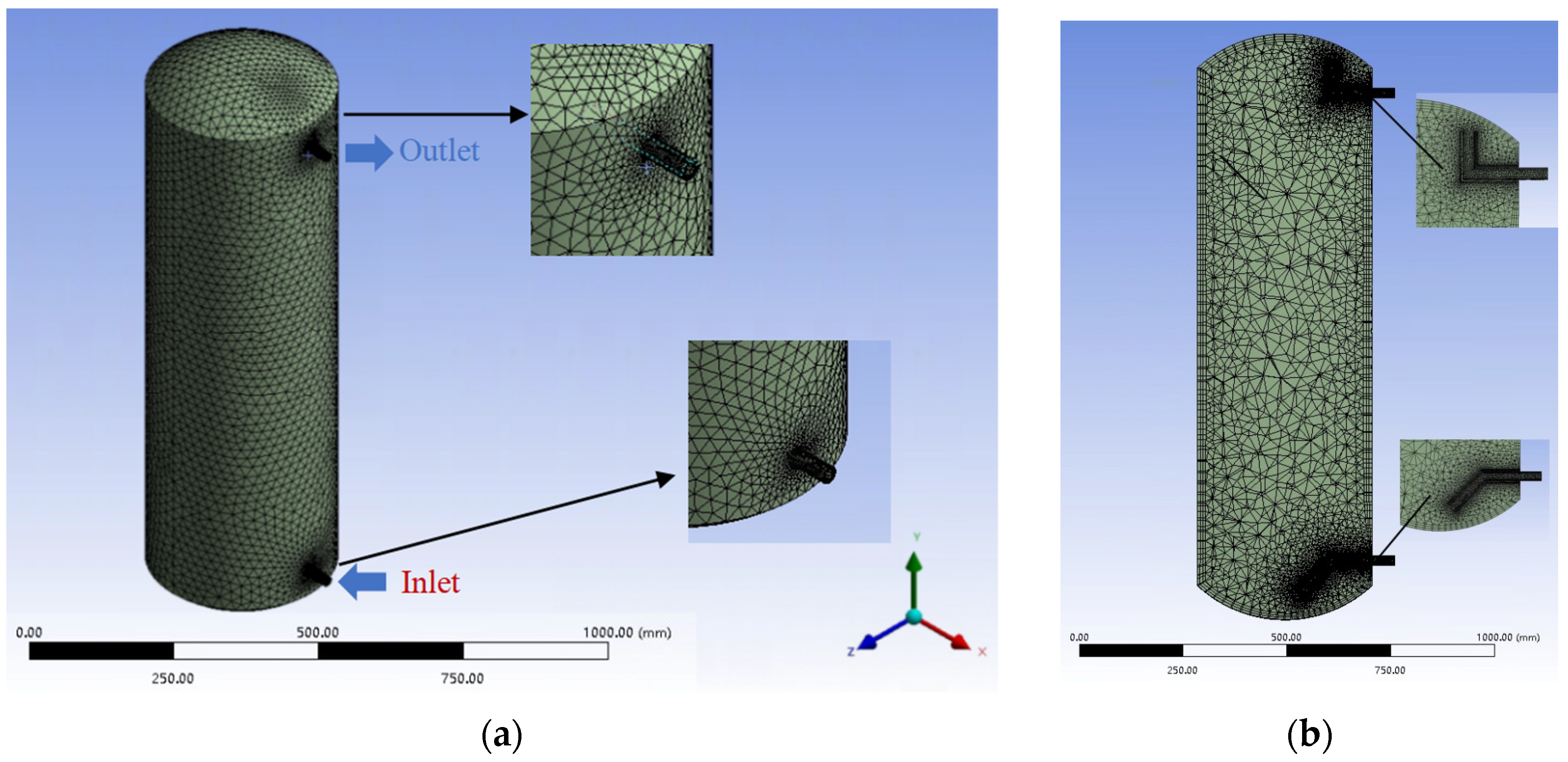


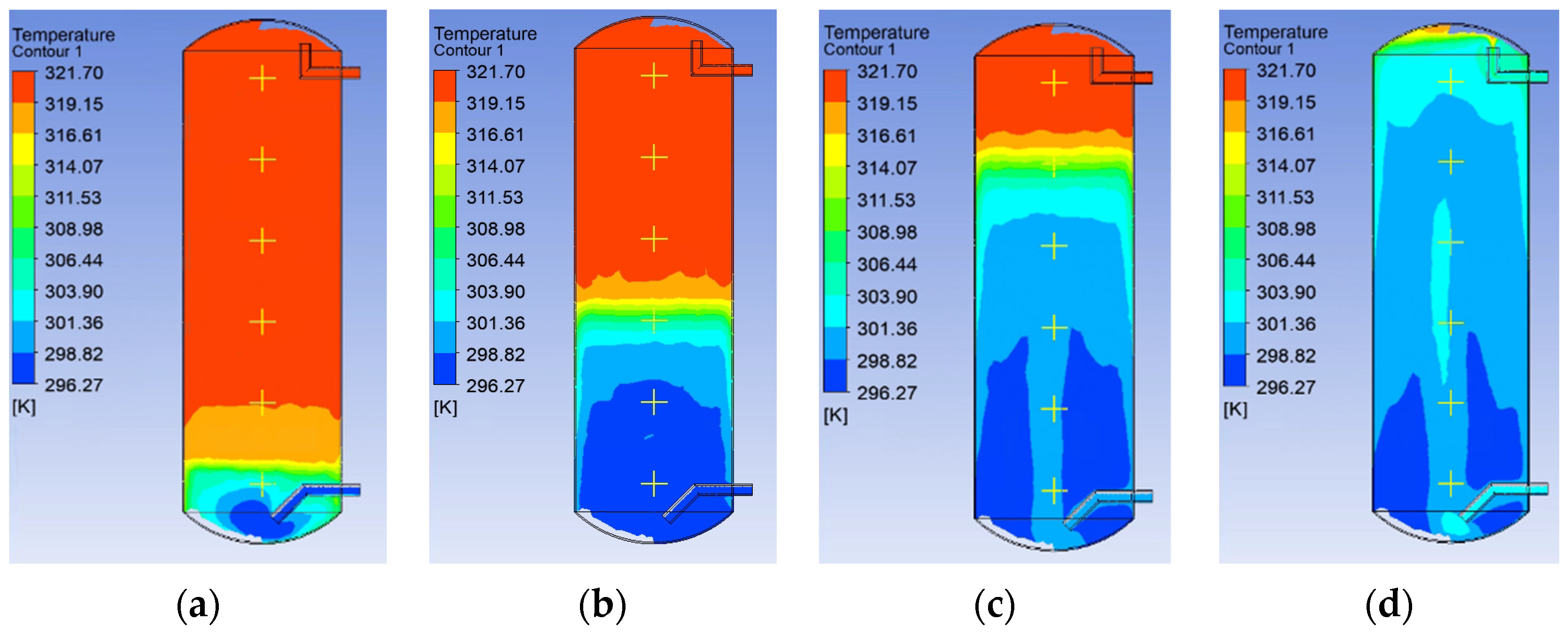



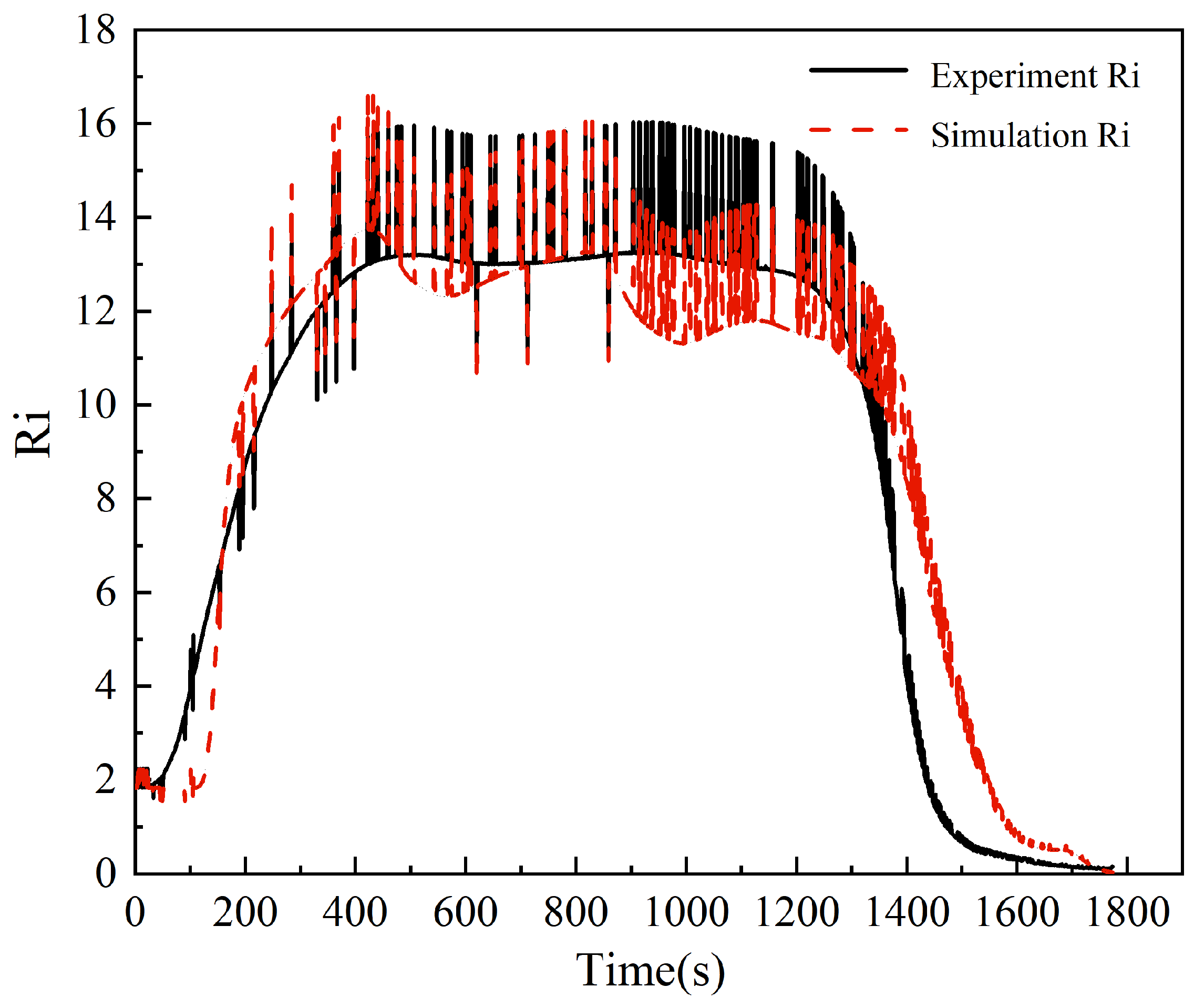

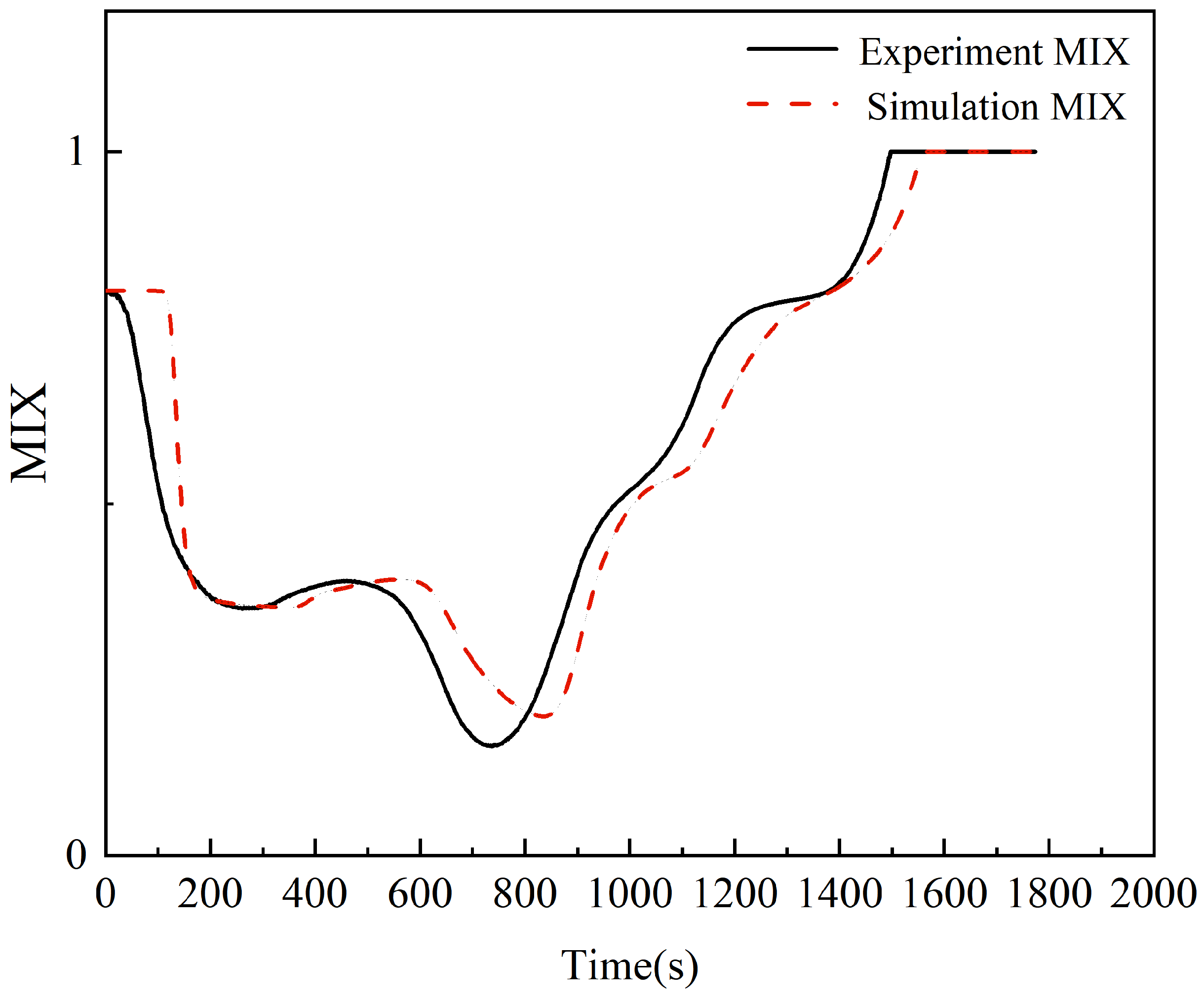

| Equipment | Manufacturer | Model Number | Range | Accuracy |
|---|---|---|---|---|
| Flowmeter | Anhui Ruiliang Measuring Instrument Manufacturing, Anhui, China | LWGY-FMT-DN20AL | 0.8 m3/h to 8 m3/h | ±0.004 m3/h |
| Temperature sensor | Shenzhen Gexinda Technology, Shenzhen, China | WZPT-035-GK-FY3PF | −50 °C to 200 °C | ±0.1 °C |
| Equipment | Heat Pump | Circulation Pump |
|---|---|---|
| Manufacturer | McQuay | ZHONGKE CENTURY |
| Model number | MWW040AR5 | DC55B-24160PWM |
| Rated power | 3.1 kW | 80 W |
| Maximum head | – | 16 m |
| Maximum flow | 2.26 m3/h | 2.4 m3/h |
| Rated voltage | 380 V | 24 V |
| Rated frequency | 50 Hz | – |
Disclaimer/Publisher’s Note: The statements, opinions and data contained in all publications are solely those of the individual author(s) and contributor(s) and not of MDPI and/or the editor(s). MDPI and/or the editor(s) disclaim responsibility for any injury to people or property resulting from any ideas, methods, instructions or products referred to in the content. |
© 2024 by the authors. Licensee MDPI, Basel, Switzerland. This article is an open access article distributed under the terms and conditions of the Creative Commons Attribution (CC BY) license (https://creativecommons.org/licenses/by/4.0/).
Share and Cite
Xing, Y.; Zhang, X.; Zhang, Z.; Liu, F. The Impact of Inlet Structure on Stratification Performance in Thermal Storage Tanks: A Study through Simulation and Experimental Analysis. Appl. Sci. 2024, 14, 5248. https://doi.org/10.3390/app14125248
Xing Y, Zhang X, Zhang Z, Liu F. The Impact of Inlet Structure on Stratification Performance in Thermal Storage Tanks: A Study through Simulation and Experimental Analysis. Applied Sciences. 2024; 14(12):5248. https://doi.org/10.3390/app14125248
Chicago/Turabian StyleXing, Yongjie, Xiaofen Zhang, Zilong Zhang, and Fang Liu. 2024. "The Impact of Inlet Structure on Stratification Performance in Thermal Storage Tanks: A Study through Simulation and Experimental Analysis" Applied Sciences 14, no. 12: 5248. https://doi.org/10.3390/app14125248
APA StyleXing, Y., Zhang, X., Zhang, Z., & Liu, F. (2024). The Impact of Inlet Structure on Stratification Performance in Thermal Storage Tanks: A Study through Simulation and Experimental Analysis. Applied Sciences, 14(12), 5248. https://doi.org/10.3390/app14125248





